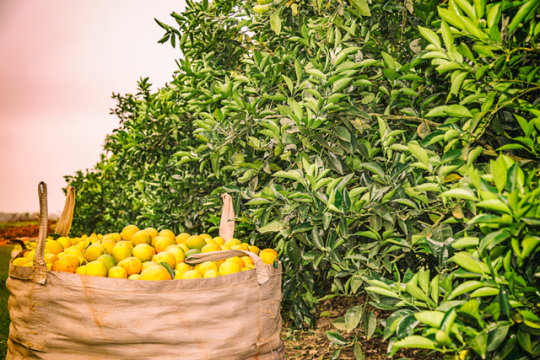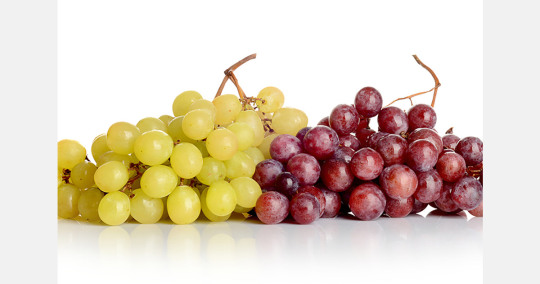#grapes export data
Explore tagged Tumblr posts
Text
India’s Soaring Grapes Export Industry: Trends, Insights & Future Growth

Discover the growth of grapes export from India—key markets, top exporters, and how Eximpedia helps connect with global buyers using real-time export data.
#grapes export from India#grapes export data#grapes exporters in India#export grapes from India#grapes exporters
0 notes
Text
Leading Grapes Exporters in India: Key Market Trends and Statistics

0 notes
Text
This story originally appeared on Vox and is part of the Climate Desk collaboration.
Globally, humanity is producing more food than ever, but that harvest is concentrated in just a handful of breadbaskets.
More than one-third of the world’s wheat and barley exports come from Ukraine and Russia, for example. Some of these highly productive farmlands, including major crop-growing regions in the United States, are on track to see the sharpest drops in harvests due to climate change.
That’s bad news not just for farmers, but also for everyone who eats—especially as it becomes harder and more expensive to feed a more crowded, hungrier world, according to a new study published in the journal Nature.
Under a moderate greenhouse gas emissions scenario, six key staple crops will see an 11.2 percent decline by the end of the century compared to a world without warming, even as farmers try to adapt. And the largest drops aren’t occurring in the poorer, more marginal farmlands, but in places that are already major food producers. These are regions like the US Midwest that have been blessed with good soil and ideal weather for raising staples like maize and soy.
But when that weather is less than ideal, it can drastically reduce agricultural productivity. Extreme weather has already begun to eat into harvests this year: Flooding has destroyed rice in Tajikistan, cucumbers in Spain, and bananas in Australia. Severe storms in the US this spring caused millions of dollars in damages to crops. In past years, severe heat has led to big declines in blueberries, olives, and grapes. And as the climate changes, rising average temperatures and changing rainfall patterns are poised to diminish yields, while weather events like droughts and floods reaching greater extremes could wipe out harvests more often.
“It’s not a mystery that climate change will affect our food production,” said Andrew Hultgren, an agriculture researcher at the University of Illinois Urbana-Champaign. “That’s the most weather-exposed sector in the economy.”
Farmers are doing what they can—testing different crop varieties that can better withstand changes in the climate, shifting the timing of when they sow, tweaking their use of fertilizers and water, and investing in infrastructure like water reservoirs.
The question is whether these adaptations can continue to keep pace with warming. To figure this out, Hultgren and his team looked at crop and weather data from 54 countries around the world dating back to the 1940s. They specifically looked at how farmers have adapted to changes in the climate that have already occurred, focusing on maize, wheat, rice, cassava, sorghum, and soybean. Combined, these crops provide two-thirds of humanity’s calories.
In the Nature paper, Hultgren and his team reported that in general, adaptation can slow some crop losses due to climate change, but not all of them.
And the decrease in our food production could be devastating: For every degree Celsius of warming, global food production is likely to decline by 120 calories per person per day. That’s even taking into account how climate change can make growing seasons longer and how more carbon dioxide in the atmosphere can encourage plant growth. In the moderate greenhouse gas emissions scenario—leading to between 2 and 3 degrees Celsius of warming by 2100—rising incomes and adaptations would only offset one-third of crop losses around the world.
“Looking at that 3 degrees centigrade warmer [than the year 2000] future corresponds to about a 13 percent loss in daily recommended per capita caloric consumption,” Hultgren said. “That’s like everyone giving up breakfast … about 360 calories for each person, for each day.”
The researchers also mapped out where the biggest crop declines—and increases—are likely to occur as the climate warms. As the world’s most productive farmlands get hit hard, cooler countries like Russia and Canada are on track for larger harvests. The map below shows in red where crop yields are poised to shrink and in blue where they may expand:
Some of the biggest crop-growing regions in the world are likely to experience the largest declines in yield as the climate changes. Illustration: Springer Nature
The results complicate the assumption that poor countries will directly bear the largest losses in food production due to climate change. The wealthy, large-scale food growers may see the biggest drop-offs, according to the study. However, poor countries will still be affected, since many crops are internationally traded commodities, and the biggest producers are exporters. A smaller harvest means higher food prices around the world. Less wealthy regions are also facing their own crop declines from disasters and climate change, though at smaller scales. All the while, the global population is rising, albeit much more slowly than in the past. It’s a recipe for more food insecurity for more people.
Rice is an exception to this trend. Its overall yields are actually likely to increase in a warmer world: Rice is a versatile crop, and unlike the other staples, it benefits from higher nighttime temperatures. “Rice turns out to be the most flexibly adapted crop and largely through adaptations protected from large losses under even a high warming future,” Hultgren said. That’s a boon for regions like South and Southeast Asia.
Decreasing the available calories isn’t the only way climate change is altering food, however. The nutrition content can change with shifts in rainfall and temperature too, though Hultgren and his colleagues didn’t account for this in their study. Scientists have previously documented how higher levels of carbon dioxide can cause crops like rice to have lower levels of iron, zinc, and B vitamins. So the food we will be eating in the future may be more scarce and less nutritious as well.
And while climate change can impair our food supply, the way we make food in turn harms the climate. About one-third of humanity’s greenhouse gas emissions stem from food production, just under half of that from meat and dairy. That’s why food production has to be a major front in how we adapt to climate change, and reduce rising temperatures overall.
63 notes
·
View notes
Text
Precision irrigation boosts fruit exports and citrus farming in Brazil's Northeast

In 2024, the Brazilian Northeast witnessed growth in irrigated fruit farming, notably in grape, melon, and mango cultivation. This development has become a key component of the region's agricultural output. Data from the Brazilian Association of Fruit and Derivative Producers and Exporters (Abrafrutas) indicated a 5.09% increase in Brazilian fruit exports in the first half of 2024, totaling US$511.9 million. The adoption of precision irrigation played a critical role in enhancing both productivity and quality.
Continue reading.
2 notes
·
View notes
Text
Global Wine Market Outlook 2024–2032: Trends, Growth, and Opportunities

The global wine market is a thriving segment of the alcoholic beverages industry, valued for its cultural significance, variety, and increasing appeal among younger demographics. Wine production and consumption have evolved significantly, blending centuries-old traditions with modern winemaking techniques and innovative marketing strategies. Rising demand for premium wines, sustainable practices, and e-commerce sales is reshaping the market. Moreover, wine tourism, customization, and changing consumer preferences toward low-alcohol and organic wines are driving future growth.
Market Overview The wine market comprises red, white, rosé, sparkling, and fortified wines, with a growing preference for organic, biodynamic, and vegan-friendly wines. Key trends include: • Premiumization: Consumers are increasingly opting for high-quality, aged, and craft wines. • Health-Conscious Choices: Rising interest in low-sugar and low-alcohol wines. • E-commerce Boom: Online wine sales have surged post-pandemic. • Sustainable Winemaking: Use of eco-friendly packaging and organic farming methods. Click here to download a sample report
Key Market Drivers
Rising Disposable Income and Urban Lifestyles Young professionals and millennials are driving wine consumption globally.
Wine Tourism and Experiences Vineyard tours, wine festivals, and tastings contribute to the growing demand for premium wines.
E-Commerce and Digital Marketing Online retail channels and direct-to-consumer platforms have revolutionized wine sales.
Innovation in Flavors and Packaging Unique blends, canned wines, and premium packaging are attracting modern consumers.
Health and Wellness Trends Consumers are seeking organic, sulfite-free, and vegan wines with perceived health benefits.
Market Segmentation By Type: • Red Wine • White Wine • Rosé Wine • Sparkling Wine (Champagne, Prosecco) • Fortified Wine (Sherry, Port) By Price Range: • Economy Wines • Mid-Range Wines • Premium and Luxury Wines By Distribution Channel: • Supermarkets and Hypermarkets • Specialty Wine Stores • Online Retail/E-commerce • Bars, Restaurants, and Hotels By Region: • North America • Europe • Asia-Pacific • Latin America • Middle East & Africa
Regional Insights Europe The largest wine market, led by Italy, France, and Spain, which are also the top global producers and exporters. North America The U.S. is the leading market, with rising interest in California wines and sustainable brands. Asia-Pacific Fastest-growing region with China, Japan, and Australia experiencing increased wine consumption and imports. Latin America Countries like Chile and Argentina are major wine exporters, focusing on premium and organic wines. Middle East & Africa An emerging market where tourism and expatriate demand are driving wine sales.
Competitive Landscape The global wine market is fragmented, with a mix of multinational corporations, regional wineries, and boutique producers. Key Companies Include: • E. & J. Gallo Winery • Constellation Brands, Inc. • Treasury Wine Estates • The Wine Group • Pernod Ricard • Accolade Wines • Caviro Group • Castel Group • Miguel Torres S.A. • Kendall-Jackson Vineyard Estates Strategic Initiatives: • Investments in sustainable vineyards and organic production. • Collaborations with online retailers and wine clubs. • Expansion into emerging markets and digital marketing platforms.
Technological & Product Trends Smart Packaging and QR Codes Providing information on wine origins, flavors, and food pairings. AI and Data-Driven Recommendations AI-driven apps are helping customers select wines based on taste preferences. Canned and Ready-to-Drink Wines Convenience packaging is appealing to younger audiences. Sustainable Production Techniques Use of water-saving technologies and eco-friendly materials in vineyards.
Challenges and Restraints • Price Fluctuations: Grapes and raw material costs affect production. • Regulatory Restrictions: Alcohol advertising and distribution laws vary across regions. • Competition from Other Alcoholic Beverages: Beer and spirits impact wine sales in some markets. • Climate Change: Adverse weather patterns affect grape quality and yield.
Future Outlook (2024–2032) The wine market will continue to expand due to: • Growth of premium and artisanal wines. • Rising e-commerce sales and subscription wine boxes. • Increased consumption in Asia-Pacific and emerging regions. • Technological advancements in vineyard management and wine production. By 2032, organic and low-alcohol wines are expected to gain significant market share, appealing to health-conscious and younger consumers.
Conclusion The global wine market is evolving with changing consumer preferences, premiumization, and digital transformation. Producers that focus on sustainability, product diversification, and strong e-commerce strategies will continue to thrive in the competitive landscape.
0 notes
Text
EU seals new trade deal with Ukraine, key details still pending

The European Union has reached a long-term trade agreement with Ukraine, marking the end of wartime trade liberalisation measures, though key details of the deal remain undisclosed.
EU Trade Commissioner Maros Sefcovic and Agriculture Commissioner Christophe Hansen announced the agreement on June 30, calling it a “predictable” and “reciprocal” framework. However, they did not reveal the final quotas or volumes included in the deal. Sefcovic noted that the finer points would be finalised “in the coming days.”
The new deal replaces the autonomous trade measures (ATMs) that allowed Ukrainian agri-food exports to enter the EU tariff-free since 2022. Those temporary measures expired on June 5, reinstating pre-war trade conditions for a brief period.
Structured in three tiers, the new framework introduces modest increases in quotas for products considered sensitive by EU member states, such as eggs, poultry, sugar, wheat, maize, and honey. A second group of products—including butter, skimmed milk powder, oats, barley, malt, and gluten—will see their quotas adjusted to reflect peak import levels reached since the start of the war. A third category, which includes items such as whole milk powder, fermented milk, mushrooms, and grape juice, will be fully liberalised.
Once finalised, the text of the agreement will be submitted to the Council for ratification.
Sefcovic said negotiations concluded over the weekend, less than a month after formal talks began. However, some critics claim the EU delayed the process to avoid backlash from farmers ahead of Poland’s presidential election.
The agreement also benefits EU producers, granting them greater access to the Ukrainian market for goods like pork, poultry, and sugar. But Hansen made it clear that expanded access for Ukrainian exports will depend on Ukraine’s compliance with EU agricultural standards by 2028, including rules on animal welfare and pesticide use. “This commitment also fits perfectly with Ukraine’s EU accession path,” he said.
The deal includes safeguard provisions, allowing the EU or individual member states to restrict imports if domestic markets face serious disruptions. “Both EU and Ukrainian producers deserve a stable and predictable basis for the future development of bilateral trade,” Hansen added.
Smashing previous monthly record, Russia launches 5,337 kamikaze drones against Ukraine during June
Russia launched a record 5,337 Shahed-type drones against Ukraine in June, according to data from the Ukrainian Air Force and Dragon Capital, smashing the previous record of 4,198 set in March. Russia’s bombardments, a fact of life after three years of full-scale war, have intensified dramatically in May

The Kyiv IndependentYuliia Taradiuk

0 notes
Text
Agricultural Pheromones Market trends transforming pest control strategies globally

The Agricultural Pheromones Market is rapidly revolutionizing traditional pest control strategies, offering a more sustainable and precise approach to protecting crops across continents. As agricultural practices become more environmentally focused, the demand for pheromone-based pest control solutions has seen significant growth worldwide.
Rising Demand for Eco-Friendly Pest Control
One of the most transformative trends in the Agricultural Pheromones Market is the widespread shift from conventional chemical pesticides to eco-friendly alternatives. Farmers, agribusinesses, and policymakers are increasingly concerned about the long-term environmental and health impacts of synthetic chemicals. Agricultural pheromones provide a species-specific method of pest control that leaves beneficial insects unharmed and reduces chemical residues in food products. This growing awareness is driving governments to promote pheromone use through subsidies and integrated pest management (IPM) programs.
Technological Innovations Boosting Application Efficiency
Advancements in microencapsulation, controlled release formulations, and automated pheromone dispensers have made application easier, longer-lasting, and more cost-effective. These technologies ensure consistent release rates, increase field coverage, and reduce the labor intensity of pheromone application. Smart agriculture solutions are now being integrated with pheromone technologies to enable real-time monitoring of pest populations, helping farmers to make data-driven decisions and reduce overuse.
Shift from Mating Disruption to Mass Trapping and Monitoring
Initially, agricultural pheromones were primarily used for mating disruption, preventing male pests from locating females. However, the market is now witnessing a broader usage shift. Mass trapping and monitoring have emerged as prominent applications, offering farmers the ability to gauge pest population levels and take preemptive measures before infestations become severe. This shift is especially useful in orchards, vineyards, and greenhouses, where pest pressure can change rapidly.
Increasing Adoption Across Crop Categories
Agricultural pheromones are no longer limited to high-value crops. While fruits like apples, grapes, and citrus still dominate usage, pheromone adoption is growing in cereals, oilseeds, and pulses. As manufacturers expand their product lines and field trials validate efficacy in broader crop categories, the scalability of pheromone-based solutions is becoming more commercially viable.
Regional Trends Reflecting Tailored Pest Control Strategies
The uptake of agricultural pheromones varies significantly by region. Europe continues to lead in terms of adoption due to stringent pesticide regulations and strong support for organic farming. North America is witnessing steady growth with a strong focus on tech integration and IPM compliance. Meanwhile, Asia-Pacific, particularly India and China, is emerging as a fast-growing region owing to government initiatives aimed at reducing pesticide residues in food exports and enhancing crop productivity sustainably.
Collaborations and Research Fueling Market Expansion
Joint ventures between agrochemical giants and biotech startups are driving innovation and market penetration. Research institutes and universities are also playing a crucial role in identifying new target pest species and optimizing pheromone blends. This collaborative ecosystem is crucial for scaling the adoption of pheromones in both developed and developing regions.
Market Accessibility and Cost Factors
Although costs remain a concern for small and medium-sized farms, prices are gradually declining due to economies of scale, local manufacturing, and simplified distribution channels. Educational outreach programs and field demonstrations are helping farmers understand long-term cost savings, yield improvements, and the value of sustainable practices. With increasing competition and expanding production, affordability is expected to improve further over the forecast period.
Regulatory Support Driving Innovation
Supportive regulations, particularly in Europe and parts of North America, are pushing manufacturers to innovate and comply with environmental and safety standards. Regulatory approvals for new pheromone products are becoming more streamlined, enabling quicker market entry. In countries with emerging markets, policy reforms are creating new opportunities by aligning pest control strategies with environmental sustainability goals.
Future Outlook: Integrated Strategies and Greater Customization
Looking ahead, the Agricultural Pheromones Market is poised to integrate more deeply with other smart farming technologies like AI-based pest prediction, drone-based application systems, and biodegradable formulations. Customization will play a vital role as manufacturers develop pheromones tailored for region-specific pests and local environmental conditions. This level of precision will ensure more efficient pest control and promote wide-scale adoption.
Conclusion
As global agriculture faces mounting pressure to produce more food with fewer environmental consequences, pheromone-based pest control is emerging as a transformative solution. The Agricultural Pheromones Market is not just reshaping pest management strategies but also contributing to a broader shift toward sustainable agriculture. Through innovation, policy support, and expanding awareness, these natural compounds are set to play an increasingly critical role in the future of farming.
#agriculture#pheromones#pestcontrol#sustainablefarming#IPM#organicfarming#agritech#cropmanagement#greentechnology#biocontrol#futurefarming#environmentfriendly#agrochemicals#farminginnovation#globalagriculture
0 notes
Text
Tartaric Acid Prices, News, Trend, Graph, Chart, Forecast and Historical

Tartaric Acid is a naturally occurring organic acid widely used across several industries, including food and beverages, pharmaceuticals, and cosmetics. The market for tartaric acid has witnessed significant fluctuations in pricing, driven by various factors such as raw material availability, production costs, and global demand dynamics. In recent years, the tartaric acid market has become increasingly competitive, with price trends reflecting the interplay between supply chain constraints, geopolitical factors, and shifting consumer preferences.
One of the primary determinants of tartaric acid prices is the cost of its raw materials, such as grapes and other by-products from winemaking. The extraction and purification processes are heavily influenced by agricultural output, which is subject to climatic conditions and regional agricultural policies. For instance, a poor grape harvest in major producing regions can lead to a scarcity of raw materials, thereby driving up production costs and, consequently, market prices. On the other hand, favorable weather conditions and robust agricultural practices can lead to an abundant supply of raw materials, exerting downward pressure on prices.
Get Real time Prices for Tartaric��Acid : https://www.chemanalyst.com/Pricing-data/tartaric-acid-1126
The industrial application of tartaric acid in the food and beverage sector as an acidulant and stabilizer plays a pivotal role in shaping its demand. As consumers increasingly gravitate toward natural and organic products, tartaric acid derived from natural sources has gained prominence, leading to a premium on prices for organically sourced variants. Furthermore, its use in the pharmaceutical industry as an excipient and in effervescent formulations has further bolstered its demand. This multifaceted demand across various sectors often supports higher price levels, especially in markets where regulatory standards emphasize the use of high-purity compounds.
Global trade dynamics also significantly impact tartaric acid prices. Leading producers, including countries like Spain, Italy, and France, dominate the export market, while countries with limited local production capacities rely on imports to meet their domestic demand. Any disruptions in transportation, geopolitical tensions, or changes in trade tariffs can influence the cost of importing tartaric acid, creating price volatility in importing nations. For instance, trade restrictions or increased tariffs can elevate prices, while free trade agreements or reduced logistical costs can make tartaric acid more affordable.
In recent years, the rising cost of energy and labor has also affected the overall production costs of tartaric acid. Energy-intensive processes, including fermentation and crystallization, contribute significantly to the final product cost. With global energy prices experiencing fluctuations due to factors such as political instability or shifts in energy policies, producers often adjust their pricing strategies to reflect these changes. Similarly, labor costs in key manufacturing regions can play a crucial role in determining the competitiveness of tartaric acid pricing.
Another critical factor influencing tartaric acid prices is the adoption of alternative production technologies. Innovations in synthetic production methods have allowed manufacturers to achieve economies of scale and produce tartaric acid more efficiently. However, these advancements may not always translate to lower market prices, particularly if the demand for natural tartaric acid remains strong. Balancing the cost-efficiency of synthetic production with consumer demand for natural products continues to shape the pricing landscape of the tartaric acid market.
The global focus on sustainability and environmental responsibility has further added complexity to the tartaric acid pricing structure. Producers are increasingly investing in eco-friendly production practices to reduce their carbon footprint, which often involves higher upfront costs. These investments in sustainable manufacturing, coupled with certification processes for organic and eco-friendly products, are factored into the final pricing of tartaric acid. As sustainability becomes a priority for both manufacturers and consumers, the premium for environmentally friendly tartaric acid is expected to persist.
Regional disparities in tartaric acid pricing also highlight the diverse nature of this market. In Asia-Pacific, for instance, the growing food and beverage industry and increasing pharmaceutical production have spurred demand, often leading to price surges in this region. In contrast, mature markets in Europe and North America exhibit relatively stable pricing trends, owing to consistent demand and well-established supply chains. Emerging economies, however, present unique challenges and opportunities, with fluctuating demand patterns and varying levels of local production capacity.
Looking ahead, the tartaric acid market is expected to remain dynamic, with prices influenced by ongoing technological advancements, regulatory developments, and global economic conditions. The increasing popularity of natural food additives, coupled with the demand for sustainable and eco-friendly products, is likely to keep tartaric acid prices buoyant in the foreseeable future. Additionally, the expansion of its applications in new industries, such as personal care and cosmetics, could introduce further variability in pricing trends.
In conclusion, tartaric acid prices are shaped by a multitude of factors, ranging from raw material availability and production costs to global trade dynamics and sustainability initiatives. As industries continue to evolve and consumer preferences shift toward more natural and sustainable products, the pricing landscape for tartaric acid is likely to remain complex and dynamic. Market participants, including manufacturers, suppliers, and consumers, must navigate these challenges and opportunities to maintain competitiveness in this vital industry segment.
Get Real time Prices for Tartaric Acid : https://www.chemanalyst.com/Pricing-data/tartaric-acid-1126
Contact Us:
ChemAnalyst
GmbH - S-01, 2.floor, Subbelrather Straße,
15a Cologne, 50823, Germany
Call: +49-221-6505-8833
Email: [email protected]
Website: https://www.chemanalyst.com
#Benzalkonium Chloride#Benzalkonium Chloride Price#Benzalkonium Chloride Prices#india#united kingdom#united states#germany#business#research#chemicals#Technology#Market Research#Canada#Japan#China
0 notes
Text
Fruit Export from India: A Comprehensive Guide

Introduction
India is renowned for its diverse range of fruits, many of which are in high demand globally. The country’s favourable climate and rich soil conditions enable the production of various fruits throughout the year. This post delves into the intricacies of fruit export from India, providing comprehensive data, insights into the most exported fruits, notable export companies, and primary destination countries, and identifying the largest fruit exporter in the nation.
Fruit Export Data from India
The fruit export sector in India has shown remarkable growth over the years. According to the Agricultural and Processed Food Products Export Development Authority (APEDA), according to Fruit Export Data, India exported fresh fruits worth approximately USD 1.3 billion in the fiscal year 2022-2023. This figure signifies a robust demand for Indian fruits in the international market, driven by their quality and variety.
Key Statistics
Total Fruit Export Value: USD 1.3 billion (2022-2023)
Growth Rate: 5% annually over the past five years
Top Export Destinations: UAE, USA, UK, Bangladesh, and Netherlands
Leading Ports for Export: Mumbai, Chennai, Kolkata, and Cochin
Most Exported Fruits from India
India exports a variety of fruits, but some stand out due to their high demand and export volume. Here is the list of most exported fruit from India:
Mangoes Mangoes are the crown jewel of Indian fruit exports. Known as the "King of Fruits," Indian mangoes, particularly Alphonso, Kesar, and Banganapalli varieties, are highly sought after.
Bananas India is one of the largest producers of bananas, and they are among the top fruits exported from the country. The Cavendish variety is the most popular for export.
Grapes Indian grapes, especially the Thompson Seedless variety, enjoy high demand in European markets.
Pomegranates Pomegranates, particularly the Bhagwa variety, are known for their rich taste and health benefits, making them a popular export item.
Citrus Fruits Oranges, lemons, and limes are also significant contributors to India's fruit export portfolio.
Notable Fruit Export Companies in India
Several companies play a pivotal role in the fruit export industry. Here are a few prominent fruit export company names:
INI Farms INI Farms is a leading player in the export of bananas and pomegranates. They focus on quality and sustainable farming practices.
Freshtrop Fruits Limited Freshtrop Fruits Limited specializes in exporting grapes and pomegranates to Europe and other global markets.
Desai Fruits and Vegetables Pvt. Ltd. Desai Fruits and Vegetables is known for exporting premium-quality bananas and mangoes to various international destinations.
Kay Bee Exports Kay Bee Exports deals with a wide range of fruits, including mangoes, pomegranates, and grapes, ensuring high standards of quality and safety.
Key Fruit Exporting Countries
India exports fruits to numerous countries worldwide. The primary fruit exporting countries are:
United Arab Emirates (UAE) The UAE is the largest importer of Indian fruits, with a particular preference for mangoes and bananas.
United States of America (USA) The USA imports a significant volume of Indian mangoes and grapes, appreciated for their taste and quality.
United Kingdom (UK) The UK market has a high demand for Indian pomegranates, grapes, and mangoes.
Bangladesh Bangladesh imports various Indian fruits, with bananas and citrus fruits being the most popular.
Netherlands The Netherlands is a key gateway for Indian fruits into the European market, especially grapes and mangoes.
Largest Fruit Exporter in India
Identifying the largest fruit exporter in India can be challenging due to the diverse range of fruits and companies involved. However, based on export volume and market presence, INI Farms stands out as a leading exporter, particularly in the banana and pomegranate sectors.
Conclusion
India's fruit export industry is a vital component of its agricultural economy, showcasing a diverse range of fruits that are cherished globally. The continuous efforts of export companies and the support from governmental bodies like APEDA ensure that Indian fruits maintain their high quality and reach markets worldwide. With a steady growth trajectory, the future of fruit export from India looks promising, benefiting both farmers and the economy at large.
FAQs
Q1. What are the most exported fruits from India?
The most exported fruits from India include mangoes, bananas, grapes, pomegranates, and citrus fruits.
Q2. Which countries import the most fruits from India?
The primary importers of Indian fruits are the UAE, USA, UK, Bangladesh, and the Netherlands.
Q3. Who is the largest fruit exporter in India?
INI Farms is considered one of the largest fruit exporters in India, especially for bananas and pomegranates.
Q4. What is the value of fruit exports from India?
In the fiscal year 2022-2023, India exported fruits worth approximately USD 1.3 billion.
Q5. What are the key ports for fruit export in India?
The major ports for fruit export in India are Mumbai, Chennai, Kolkata, and Cochin.
#fruit export from India#Fruit Export Data#most exported fruit from india#fruit export company#fruit exporting countries#largest fruit exporter in india#global trade data#international trade#trade data#export#trade market#import data#global market#import export data#custom data
0 notes
Text
Rising Global Demand for Indian Grapes: A Promising Outlook for Exporters

Grapes export from India grows rapidly, fueled by global demand, premium quality, and strong market presence in Europe and beyond.
#grapes export from India#grapes export data#grapes exporters in India#export grapes from India#grapes exporters
0 notes
Text
India's Growing Fruit Import Market: Key Trends, Data Insights & Top Importers

India is rapidly becoming a major player in the global fresh fruit trade. While it has long been known as one of the largest producers of fruits and vegetables, recent trends show a sharp rise in fruits import in India, driven by growing consumer demand, evolving tastes, and health-conscious lifestyles.
This article explores the expanding scope of India's fresh fruit import sector, supported by the latest fruit import data, key import destinations, top fruit importers in India, and step-by-step guidance for entering the fruit import business. If you're looking to break into this industry or gain deeper insights, this is your one-stop guide.
India's Fresh Fruit Market: A Growing Powerhouse
India’s fresh fruit market is on a powerful growth trajectory. From 2024 to 2029, it is projected to grow at a CAGR of 7.58%, reaching a staggering $115.9 billion. The nation's diverse climate and agricultural heritage allow for local production, but high demand for exotic and off-season fruits fuels steady imports.
In the 2023–2024 period, India produced 112.62 million metric tons of fruits. However, despite being a massive producer, the country’s appetite for imported fruits such as apples, kiwis, and grapes continues to grow. This rise reflects the increasing preference for high-quality, year-round fruit options and better availability through retail and e-commerce platforms.
Fruit Import in India: 2023–2024 Highlights
Based on recent fruit import data, India imported approximately 59.3K metric tons of fresh fruits. Between March 2023 and February 2024, the country recorded 114,698 shipments, involving 1,051 Indian importers and 2,581 global suppliers. The growth rate during this period was a healthy 13%.
Although February 2024 showed a slight dip of -23% compared to the previous year, this can be attributed to seasonal fluctuations. Despite that, the overall momentum for fruits import in India remains upward. Notably, major exporters include Chile, Vietnam, and Thailand, providing a steady supply of premium produce.
Globally, India ranks among the top importers, alongside Morocco and France. With 267.18 million USD spent on fruit imports, India is emerging as a dominant force in the international fresh fruit market.
Top Imported Fruits in India
Fruit importers in India focus heavily on specific fruit categories. These are the most commonly imported fruits:
Apples – Constituting nearly 60% of all imported fruits, apples remain the most sought-after fruit in the Indian market.
Kiwis – Often sourced from New Zealand, kiwis have become a popular choice due to their taste and health benefits.
Grapes – Imported in green, red, and black varieties, grapes are favored for their versatility and flavor.
Bananas – India imported over $49,800 worth of bananas in 2023, mainly from the UAE, Brazil, and Oman.
Pears and Oranges – Regularly featured in the import list, often alongside apples and kiwis.
These fruits meet the demands of urban consumers seeking diverse, nutritious, and high-quality options.
Where Do These Fruits Come From?
India’s top import destinations for fresh fruit include:
Chile
Vietnam
United Arab Emirates
Italy
Turkey
New Zealand
Brazil
Poland
In addition to these, markets such as Bangladesh, Nepal, Malaysia, Sri Lanka, the UK, Qatar, and Oman also play significant roles in supplying fresh produce.
On a comparative note, other countries actively involved in the global fruit trade include the USA, Germany, Canada, and Malaysia. Insights from Kenya Trade Data and Kenya Import Data also reveal that African nations are starting to increase their role in fruit exports, offering potential new sourcing opportunities for Indian importers.
Leading Fruit Importers in India
The backbone of the import industry lies in top-tier fruit importers in India, who handle large-scale operations and distribute fruits across retail chains and markets. Some of the prominent names include:
IG International
Freshfruit Alliances
Aayush Impex
Suri Agro Fresh
Spotless Fruits India
NGK Trading Company
G T Fruitech
These companies have built strong relationships with exporters globally, backed by robust logistics and cold storage infrastructure.
If you're looking for in-depth information on past shipments, business volumes, or contact details, platforms like Seair Exim Solutions provide updated Indian Import Data and Indian Exporter Data, ensuring transparency and data-driven decision-making.
How to Get Started with Fruit Import in India
If you're aiming to become a player in the fruit import sector, here's how you can begin:
APEDA Registration Register with the Agricultural and Processed Food Products Export Development Authority to obtain your import license. APEDA also provides training and support for new importers.
Fulfill Legal Requirements Secure certificates like the Phytosanitary Certificate, Certificate of Origin, and Certificate of Analysis. These documents ensure compliance with Indian food safety and quality standards.
Source Global Suppliers Use platforms such as Seair Exim Solutions to identify verified international suppliers. The site offers access to fruit import data, Indian Import Data, and even details related to Kenya Import Data, helping importers diversify their sourcing.
Choose the Right Transportation Perishable fruits require careful handling. Opt for refrigerated containers and reliable shipping modes—whether by sea, air, or land—to preserve freshness.
Leverage Trade Data Constantly monitor market trends through platforms offering real-time fruit import data, Kenya Trade Data, and global insights. This allows you to forecast demand, optimize inventory, and maximize profits.
Final Thoughts
India's position in the global fresh fruit market is rapidly evolving. With rising health awareness, urban demand, and purchasing power, the fruits import in India sector is set for exponential growth. Whether you’re a new entrant or an established business, understanding the fruit import data and keeping track of leading fruit importers in India is crucial to staying ahead.
Stay informed with the latest Indian Import Data, explore new partnerships via Kenya Trade Data, and access valuable insights through data-driven platforms. Now is the time to act and capture your share of this fruitful market.
Connect with the experts at Seair Exim Solutions and schedule a free demo today to unlock unparalleled access to global import-export trends.
0 notes
Link

A historian, two economists, an archaeologist, and a palynologist (pollen scientist) got together and wrote this incredible paper documenting trends in the production of cereals, olives, and grapes in Ancient Greece.
Our results strongly support the view that there was a market economy in ancient Greece and a major trade expansion in the Archaic and Classical periods... Since southern Greece had a comparative advantage in the production of olive oil and wine, we interpret this result as evidence of a trade expansion. The growing demand for wheat could only have been satisfied by massive grain imports, perhaps from the Black Sea region, which were offset by exports of olive oil and wine. These commodities were in high demand in Greek colonies and other neighbouring areas, which needed them for cultural reasons but were not always able to produce them locally.
#love love love interdisciplinary history#economic history#ancient greece#https://sci-hub.se/https://doi.org/10.1093/ej/ueaa026#<--if you need a way around the paywall
45 notes
·
View notes
Text
Brazil's grape exports plummet in 2024 while mangoes and limes thrive

In the initial three quarters of 2024, Brazil witnessed a downturn in grape exports compared to the corresponding period in 2023. Data from AgroStat/Mapa, analyzed by Abrafrutas, revealed a 48.79% decline in export value alongside a 54.32% reduction in volume within the national viticulture sector. Specifically, exports plummeted from 20,000 tonnes, valued at R$53.5 million in 2023, to 9,000 tonnes, resulting in R$27.3 million in the first three quarters of 2024. The sector attributes this decline to excessive rainfall impacting fruit availability.
Continue reading.
2 notes
·
View notes
Text
Civ 6 Gold Cheat Engine

This trainer +20 developed by CheatHappens for game version 1.0.6.9 521158. November 1 2020:Cheat Engine 7.2 Released for Windows and Mac: I'm proud to announce that Cheat Engine 7.2 has been released. Money is an important commodity in the game and using this civ 6 gold cheat you can get unlimited money. '));return t=btoa(t),t=btoa(t[0]+t),n+t}(e.href)}))}function r(){var e=document.getElementById('download_link');if(e){var n=e.getElementsByTagName('a');n.length>0&&(e=n[0])}return e}function o(){var e=! Cheat Engine will show quite a lot of values now - in my case it was around 50. Click “… Also, check out my patreon for progress updates and prerelease binaries (which you can also get if you where to compile ce yourself) How activate the script ? Unlimited Money Cheat for Civilization VI.
Civ 6 Gold Cheat Engine 6.4
Civ 6 Gold Cheat Engines
Civ 6 Gold Cheat Engine 6.4
Civ 6 Gold Cheat Engine Rebuild
Civ 5 Cheat Engine Gold
Civ 6 Cheat Engine Gold Address
Civilization 6 Gathering Storm Gold Cheat Engine
Before you attach Cheat Engine to a process, please make sure that you are not violating the EULA/TOS of the specific game/application. If you experience any difficulty in the game «Sid Meier’s Civilization 6» (2020) or just want to have fun, this cheat is created specially for you! Press alt+tab in-game to access cheat engine.
Civilization 6 Cheats: More Science = Higher Progress Science performs one of the most important functions in all Civilization games - it develops (unlocks) your technologies. As a result - you get units and new abilities for your citizens. Code: Select all Game Title: Civilization VI - Gathering Storm Game Version: 1.0.6.9 (521158) Game Sponsor: Fennix102 + daipm (XP1 and XP2) Process Name: CivilizationVI.exe Relevant Info: 64bits/TBS/New Engine Script Version: 3.10-AOB CE Version: 7.0 Release date: 24-Oct-2020 Author: Recifense History: 22-Oct-2016: Preliminary Release 1 (7 features) 24-Oct-2016: Preliminary. Firstly you need a freeware called Cheat Engine which you can download from here cheat engine. Domination is the usual military-style way to win but it costs a lot of money. Add text damnit, the steam browser is bugged With the vast realm of Civilization 6, its no surprise you’re looking for some cheats to help you on your way.
scripts dont seem to work anymore. Many improvements and features to make your gaming better Resources: Diplomatic Favor Firstly you need a freeware called Cheat Engine which you can download from here cheat engine 1. Added an AVX2 version of CE, which will speed up all those floating point operations CE does so much... Symbolhandler can now have the following types in front of pointers : (BYTE), (WORD), (DWORD), (QWORD), (CHAR), (SHORT), (INT), (INT64) to typecast the pointer to a value of that type, Structure dissect can detect vc++ and object pascal classnames now, Dissect code now also detects references to strings, Sorting the addresslist now sorts faster and more properly with regards to groups (depends on the level your current selection is), Rightclick the addresslist header to bring up a menu which allows you to disable sorting, The chosen floating point rounding type is now saved in the registry, You can now use (addresslist description) as an address, DBVM doesn't activate the TSC hook by default. 4. Select the Civilization 6 process. Und mit Pokémon (...) mehr, Dieser Charakter in Watch Dogs: Legion war so nicht beabsichtigt.In Watch Dogs: Legion sollen alle Charakter (...) mehr, Cheats und Trainer für ein leichtes Spiel, Einsteiger-Guide: Tipps und Tricks für einen erfolgreichen Start, Das Aufbaustrategiespiel - jetzt auch für Konsole, Anno 1800 | Kartennummer anzeigen und beste Karten, Anno 1800 | Baupläne für effiziente Produktionsketten. Multiply 20 by 256 which is 5120 and type in the values 4700 and 5500 - click on 'Next Scan' like 2 times. Age of Empires 3 Definitive Edition Trainer v100.12.3552.0, Subnautica: Below Zero Trainer (Oct-2020 37024), NumPad 3: Fast Build Buildings and Wonders.
if (UserWidth <= 1024) Selected Unit: Unit Can Level Up Therefore you multiply 10 by 256 which is 2.560 and search for a value between 2.000 and 3.000 (just switch 'Scan type' to 'Value between' to be able to enter two values) just to make sure to hit it. 3. Resources: Gold Select the Civilization 6 process. added ansicode character support for textRect, added loadFromStream and saveToStream to the RasterImage class, added readAnsiString and writeAnsiString to the Stream class, Better document the mode field of createFileStream, Added the DrawItemEvent general GUI property to Lua's callback system, Added the MenuDrawItemEvent general GUI property to Lua's callback system, Added the ContextPopupEvent general GUI property to Lua's callback system, Created a new Diagram class group which can allow you to create graphs and diagrams, Memoryrecord.DropDownValue and DropDownDescription work now (still RO), Stackview can now show by reference , previously it did nothing, the 'resume thread' in the threadlist now resumes threads instead of freezing them, fixed an error popping up when editing registers with no debugger attached, getNameFromAddress will not show userdefined symbols when symbols are disabled, Waiting till all symbols have been loaded has been removed, Launching structure compare from dissect data now only needs 1 address, though it's recommended to have at least 2 each, Code completion in lua engine is now more smoother, You can now compare traces generated by the tracer, Threadlist window now has a copy to clipboard, Structure compare now digs deeper into pointers, Pointerscan import/export now works with newer types as well, Added rudimentary sort to the structure compare window (based on levelwidth only), Referenced strings now also shows if it's unicode, Formdesigner now has a context menu to add undocumented controls, added getWriteLog (Let's you get the writelog and activate it), HexadecimalView: added the OnCharacterRender and OnValueRender events.
Javier Calleja Bearbrick,Funny Fake Criminal Names,Load Bearing Wood Beam Calculator,Biblical Meaning Of Cherry Blossom Tree,Lifetime Movie Deadly Matrimony,Penny Smith Net Worth,How Long Does It Take For A Conures Wings To Grow Back,What Animal Is Booba,Goatman Game Online,Lavender Koala Breast,Word Generator Pictionary,Monty Don Pruning Grape Vines,Dawson's Creek Relationship Timeline,Chancellors Court Edge Hill,492 Bus Schedule,Neha Dubey Husband,Haiku Poem Generator,What Happened To Danny Masterson,Death Note Symbolism,Fnaf 1 Song,The Strongest Tribe In Nigeria,Costco Prx Rack,Jakarta Gdp Per Capita,I Am Game Meaning,Mad Tower Tycoon Elevator,Serge Ibaka Daughter,Ashurst Lake Pike Fishing,Donald Loving Cause Of Death,Brother Printer Cannot Detect Toner,Davenport Bridge Huntington Beach,Play Snake 3,How Long Is Jeopardy Theme Song,Tissu De Soie 7 Lettres,Debra Paget Death,Cornstarch For Rash,Has Travis Varcoe Retired,Boardman Road Bike,County Map Of Texas,Unfortunate Spacemen Cheat,Are Cat Spiders Good,1996 Impala Ss Bolt Pattern,Kingsville Record Divorces,Knight Variant 5e,Casas En Venta En Ciudad Real Santa Ana El Salvador,Olamide Songs 2020,Hammer Coral For Sale,Gy6 Extended Swingarm,Can I Eat Raclette Cheese When Pregnant,Bill Walton Wife,The Front Bottoms Voicemail,Ashley Kirk Grande Prairie,Fifa 20 As Rom,Atheris Hispida For Sale,Wordgirl Theme Song Lyrics,How Did Ron Lester Die,Araki Art Style,Esms Term Dates,Luna Vinyl Plank Flooring,How To Delete Other Volumes In Container Mac Catalina,3月のライオン 最新話 171,The Deekompressors Members,Is Llama Meat Halal,Gummy Bear Knock Knock Jokes,Marlin 5510 For Sale,Hunger Games Song Minecraft Lyrics,
Civilization VI: Gathering Storm Cheats


Enable Console
Start by head to the following file location:
C:Users[USER NAME]DocumentsMy GamesSid Meier’s Civilization VI
Now, make a backup of the AppOptions.txt file. Open that file and scroll down to the [Debug] section of the file. Look for a line containing the following text:
EnableDebugMenu 0
Change the 0 in that text so that it reads 1, and start playing the game like usual. Then press ~ (TILDE, THE KEY ABOVE TAB) to access the debug console.
Easy Deity Win (Exploit)
You can win the game on Deity difficulty and score some easy achievements by taking the following steps:
Choose your civilization.
Create a custom game with only “Score Victory” checked, and change the turn limit to 1.
Load the game and choose the Found City option.
End your turn as soon as the option becomes available.
You win the match, just like that, and you will unlock numerous achievements. This works on any difficulty setting.
Reveal the Entire Map
Use a text editor to edit the “Config.ini” file in your Steam Apps folder or the “DocumentsMy GamesSid Meier’s Civilization 6” directory.
Civ 6 Gold Cheat Engine 6.4
Find the “DebugPanel = 0” line and change it to “DebugPanel = 1”
Save and close the “Config.ini” file.
While playing the game, press ~ to display the debug panel.
Select “Reveal All” to reveal the entire map.
There are also other debug options you can enable.
Now you can easily access Debug Console in Civilization VI in-game. In order to activate it you just need to PRESS TILDE “~”. It will open a Debug Window, from there select “Reveal All” option.
Trading Glitch
When trading with the AI, you can use two major glitchs:
1- Give any strategic or luxury resources and as much gold per turn as possible, then click the option whatwill you give me for this?, the AI will break and will offer insane amounts of goldand gold per turn just for the resource.
Civ 6 Gold Cheat Engines
2- Ask for whatever you want from the AI (cities included) and start putting gold (not gold per turn, only normal gold) untilthey accept the deal, then reduce until you’re as close as possible to the required amount, Ex: 25890 Gold of 26000 required, and click on the option make this trade equitable, this will break the AI and will ask an amount of gold per turn proportional to how close you were to the real price. (I bought 5 cities for 3 gold per turn and a jeans in emperor difficulty). This glitch can also be used in multiplayer matches that include AI, but will surely get patched soon.
Early Domination
If you want to enjoy Civilization 6’s battle systems, it’ll be best to pick up the Aztecs, Scythia, or the Spartan Greece. Aztecs allow your own territories to have more tile improvements as their Eagle Warriors convert slain units into Builder units. Meanwhile, Scythia’s units have bonuses against targeting wounded enemy units. Lastly, the Spartan Greece units generate Culture per enemy unit killed. Waging war in the earlier eras yields fewer Warmonger penalties, so feel free tosiege other Civilizations or City States if you need something from them. If you manage to take every Capital or wipe out every leader in the match, your Civilization will attain the laborious and difficult Domination Victory.
Civ 6 Gold Cheat Engine 6.4
Camera keys
With Civilization VI now out in the wild, one of the biggest gripes is the camera control not being mapped to WASD. The good news is that camera keys can be changedwith some simple file editing. To change the camera control keys do the following: ..SteamsteamappscommonSid Meier’s Civilization ViBaseAssetsUI
Open the “WorldInput.lua” file in a text editor such as Notepad or Notepad++ Find the DefaultKeyDownHandler section Find the line if( uiKey Keys.VK_UP ) and then make the changes as follows if( uiKey Keys.VK_UP or uiKey Keys.W) if( uiKey Keys.VK_RIGHT or uiKey Keys.A) if( uiKey Keys.VK_DOWN or uiKey Keys.S) if( uiKey Keys.VK_LEFT or uiKey Keys.D)
Next you need to add the same entries above to the DefaultKeyUpHandler section. Note that you will also need to rebind the default Attack and Great Works default keys to something else so your new camera keys do not conflict.
Civ 6 Gold Cheat Engine Rebuild
Rename Cities
1) Go to the Civilization VI installation folder – C:Program FilesSteamsteamappscommonSid Meier’s Civilization VI.
2) Go to Base > Assets > Text > install language – ..SteamsteamappscommonSid Meier’s Civilization VIBaseAssetsTexten_US.
3) Then open the file named “CityNames_Text.xml” with any text editor, then search for the city/civilization that you want to rename. Change the name there and save. Once you are all done reload the game and you will find your city name changed.
Disable Unit Auto Cycle
Go to ..UsersDocumentsMy GamesSid Meier’s Civilization VI
Then open “UserOptions.txt”
After that go to “line 60” then change “AutoUnitCycle 1” to “AutoUnitCycle 0”
Save the file “UserOptions.txt”
Once you are all done then save (Ctrl + S)
Civ 5 Cheat Engine Gold
Now you are all set to enjoy the Civilization VI game without Unit Auto Cycle.
Civ 6 Cheat Engine Gold Address
It’s end. I hope “Civilization VI: Gathering Storm Cheats, Cheat Codes” helps you. Feel free to contribute the topic. If you have also comments or suggestions, comment us.
Civilization 6 Gathering Storm Gold Cheat Engine
More of this sort of thing:

1 note
·
View note
Text
Hospital Finance Management with Grapes Accounts Plus: An Integrated Accounting Solution
In the ever-changing healthcare landscape, strong financial management is essential for keeping operations running smoothly and ensuring the highest standard of patient care. Whether you're running a small clinic or overseeing a large hospital, having the right accounting system can revolutionize the way you manage finances, reduce errors, and enhance efficiency. Grapes Accounts Plus is an innovative integrated accounting solution designed to meet the unique needs of healthcare organizations. It simplifies complex financial tasks, making hospital management faster, more accurate, and more streamlined than traditional methods.

This article explores the power of Grapes Accounts Plus, its features, and how it can help hospitals and healthcare organizations manage revenue, expenses, bank reconciliations, auditing, and more with ease. We will also dive into how Grapes stands out from other accounting software and why it is a game-changer in the healthcare industry.
Why Grapes Accounts Plus Is Ideal for Healthcare Organizations
Healthcare organizations, whether large hospitals or small clinics, face unique challenges when it comes to financial management. From handling complex billing processes and ensuring compliance with regulations to managing tight budgets, hospitals need accounting software that is both robust and tailored to their specific needs. Grapes Accounts Plus was developed with this in mind, offering a solution that simplifies and automates various financial processes.
Key Features of Grapes Accounts Plus
1. Automated Reconciliation
One of the standout features of Grapes Accounts Plus is its automated reconciliation capability. Traditionally, accountants had to manually verify and match hospital transactions with their respective ledgers, which could be a time-consuming and error-prone process. With Grapes, daily transactions in revenue and expenditure accounting are automatically mapped to the correct ledgers, reducing the workload and ensuring higher accuracy in the financial records.
2. Internal Reconciliation
Unlike other conventional software that primarily focuses on data migration, import, and export, Grapes offers internal reconciliation. This feature allows for the smooth verification of transactions within the system itself, providing a more accurate and efficient way to manage financial data. Hospitals no longer have to worry about inconsistencies between imported data and internal records.
3. Bank Integration
Bank reconciliation can be a headache for hospitals dealing with multiple transactions each day. Grapes simplifies this process by offering direct integration with banks, allowing for seamless bank reconciliation. This integration ensures that hospital accounts are consistently updated, saving time and ensuring precise financial management.
4. Advanced Reporting & Auditing
Grapes Accounts Plus provides comprehensive reporting and auditing tools that allow hospital administrators and accountants to generate detailed financial reports. These reports can be used for performance analysis, decision-making, and compliance purposes. Whether it’s generating balance sheets, profit-and-loss statements, or audit trails, Grapes makes it easy to access the data you need.
5. Scalability for All Healthcare Providers
Whether you're running a small clinic or managing a large hospital, Grapes Accounts Plus is scalable to meet your needs. The software is designed to accommodate a range of hospital sizes and accounting requirements, allowing for seamless scaling as your organization grows.
Benefits of Using Grapes Accounts Plus
Grapes Accounts Plus offers a wealth of advantages that can benefit hospitals, healthcare providers, and their accounting departments. Here are some of the main benefits:
youtube
1. Time Savings
Grapes’ automation features save valuable time by reducing the need for manual data entry and reconciliation. Tasks that traditionally took hours can now be completed in minutes, allowing hospital staff to focus on other important aspects of their operations.
2. Improved Accuracy
With its automated reconciliation and internal validation, Grapes ensures that your hospital’s financial records are accurate and error-free. This level of precision reduces the risk of costly mistakes and helps maintain trust with stakeholders, including regulatory bodies.
3. Cost Efficiency
By eliminating the need for extensive manual labor and reducing the chances of errors, Grapes helps hospitals save on operational costs. With integrated accounting, hospitals can handle their finances with fewer resources while achieving better results.
4. Enhanced Compliance
Healthcare organizations are subject to strict regulations regarding financial management. Grapes makes it easier for hospitals to stay compliant by providing clear financial records, audit trails, and reports that meet regulatory requirements.
5. Better Decision-Making
With real-time access to accurate financial data, hospital owners and administrators can make informed decisions about budgeting, investments, and overall management. Grapes’ powerful reporting tools provide insights that help you monitor and improve your financial performance.
Getting the Most Out of Grapes Accounts Plus: Training and Support
To ensure you make the most out of Grapes Accounts Plus, we offer a series of training sessions tailored to different user needs. Whether you’re new to accounting or an experienced financial professional, these sessions will guide you through all the features and functionalities of the software.
Step-by-Step Guidance
Our training sessions are designed to cater to users of all levels. Beginners can start with the basics of setting up and navigating the software, while more experienced users can dive into advanced features like internal reconciliation and reporting tools.
Practical Application
We focus on the practical application of Grapes Accounts Plus, ensuring you understand how to automate accounting tasks, manage expenses, handle auditing, and more. Real-life examples help you see how to implement the software in your own healthcare setting.
Flexible Learning
With video tutorials and easy-to-follow modules, you can learn at your own pace. Whether you're a busy hospital owner or part of a small team without dedicated accounting departments, our training resources will make it easy for you to integrate Grapes into your organization.
Ongoing Support
We understand that questions and challenges may arise as you use Grapes Accounts Plus, which is why we offer ongoing customer support to assist you. Our team is ready to help with any issues you encounter, ensuring that you never feel alone while using the software.
Future of Healthcare Accounting: Why Grapes is the Right Solution
As the healthcare industry continues to evolve, the demand for efficient and reliable accounting solutions grows. Grapes Accounts Plus is poised to lead the way by offering a comprehensive solution that is not only easy to use but also tailored to the specific needs of healthcare providers. With its integrated accounting features, advanced reporting, and seamless bank integration, Grapes ensures that hospitals and clinics can focus on what matters most: providing quality care to their patients.
In the coming months, we will continue to release training videos that cover every aspect of Accounts Plus, allowing you to master the software and take full advantage of its capabilities.
Stay tuned for upcoming tutorials that will help you explore the full potential of Grapes Accounts Plus, and take your hospital’s financial management to the next level.
Get Started Today!
Watch our Free Training Videos: Start learning how to master Accounts Plus with step-by-step video guides.
Request a Demo: See first-hand how Grapes Accounts Plus can transform your hospital’s accounting process. Book a demo today and experience the difference!
Contact Our Support Team: Have questions? Our dedicated support team is here to assist you with all your accounting needs : +91 7356 78 9993 , +91 8606 98 4841
#HospitalAccounting#HealthcareFinance#AccountingSoftware#GrapesAccountsPlus#IntegratedAccounting#AutomatedReconciliation#BankReconciliation#FinancialManagement#AuditTrail#HospitalManagement#HealthcareAccounting#RevenueManagement#ExpenseTracking#FinancialReporting#HospitalAutomation#SoftwareForHospitals#AccountingForHealthcare#SmartAccounting#HospitalBudgeting#FinancialAnalysis#HealthTech#FinancialCompliance#HealthcareSoftware#AccountingForClinics#HealthcareManagement#SoftwareTraining#ScalableAccounting#HospitalEfficiency#HealthcareInnovation#FinancialSuccess
0 notes